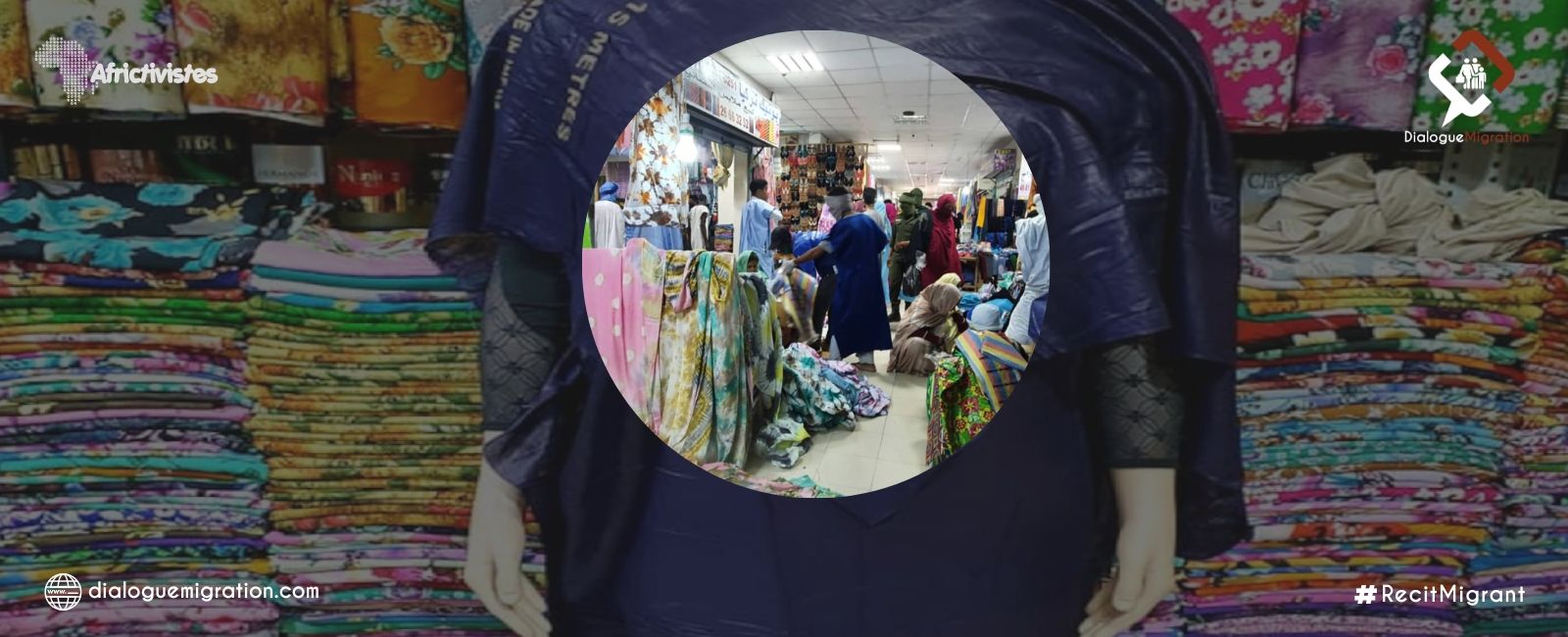

All Mauritanian women from the Moorish or Haratin community, for cultural and religious reasons, dress only in “Melahfa”. It is a traditional dress worn by the Moors as by the other women of the country which ended up being the identity of the Mauritanian woman. Over time, it modernized, took on colors and conquered the international market. The central market of Nouakchott is one of the places where the trade of “Melahfa” is the most developed in the capital.
At the central market in Nouakchott, you can find it everywhere. Its bright colors, exquisite fragrances and sparkles do not leave indifferent. Melahfa is everywhere! That is the reason you find it on the floor, on tables, shelves, in shops. It is also in people’s minds, since it is a very frequent topic of discussion.
This morning, the central market is very noisy as usual. Men and women go about their business. Between customers looking for the best prices and sellers wishing to sell their goods, negotiations are going well. Despite the hodgepodge, the veil does not go unnoticed. In fact, even the saleswomen wear them. In this market, because of the high demand, men and women, young and old, are active around this lucrative business.
The Melahfa, or veil, a dress that is also found throughout the Sahara-Sahelian space, is particularly popular in Mauritania. As the saleswoman explains, “Mauritania is a Muslim country and Islam recommends that women cover their private parts. The way we wear it allows us to cover our whole body.”
Even though Melahfa did not originally come from their country, Mauritanian women eventually adopted it and made it a marker of identity. The difference is just in the way you put on this outfit, the model and some other small details. “Anyone who knows the women of Mauritania is bound to think about their particular clothing,” says Mahmint Mahjoub. They have been doing business in this sector for a very long time. Mah, veiled with a very smiling fair complexion, informs that this fabric entered the country through pilgrims who passed through Sudan on their way back from Mecca. They bought them as gifts to their wives and children. Today, the trend has been reversed. Many countries, especially those in sub-Saharan Africa, obtain this veil from Mauritania. The country has become a hub of the “Melahfa”. However, informs the saleswoman, “Mauritania does not manufacture veils. The fabrics come from India but especially from China.” Once in Mauritania, the women take care of the dyeing, the patterns and the sale.
On this hot morning, the atmosphere is not lacking at the central market. The comings and goings of customers combined with calls from merchants give an impression of indescribable cacophony. In this crowd, Aicha, young woman in her thirties, with morphology reminiscent of the traces left by force-feeding, is of black complexion. Wearing a veil in green and white colors, she comes to look for others. Aicha explains that from what she knows, «in the past, Moorish women wore this garment with a unique black cloth that pulls on the blue at night, called Nila. At that time, there were no lightening products, but Nila allowed for clear and glowing skin.”
Today, other varieties have arrived on the market. The Melahfa of modern times is either cotton or silk. Prices also vary depending on the qualities. The simple veils, Khartoum, cost about 1500 Ouguiyas, which is around 26,000 FCFA, (39 euros). Khiyatas (models with traditional stitching and dyes) are expensive and can go up to 30 or 40 thousand ouguiyas, about 70,000 FCFA, (106 Euro). There is something for every taste, but also for every occasion. There are classy veils for parties, ceremonies, dinners called digital, emirates etc.
Some categories cost between 9000 and 10000 (Swari, Mouftilla, gauze, etc.). The most expensive are the silk veils worn by the sour cherry artists which cost up to 150,000 mro. For Aisha, there is no need to complain about prices, “since the models are different and the veil is sold everywhere, we have the choice and each person buys according to his means,” she says, holding a veil in her hands and chatting with a salesman.
Perfect for all occasions
The veil trade is very lucrative. They are bought for almost every occasion, especially weddings, “business is good,” she says. She continues: “Mauritanian women wear them every day, without exception, so every day we sell them,” says the saleswoman. However, periodically, new patterns and designs need to be created to vary supply and stimulate demand.
One of the occasions for which the “Melahfa» is most honored is undoubtedly the wedding. For this particular event, it is displayed in duplicate on the first day of the bride at her husband’s home. Mah explains that “the woman must wear a model of veil either brown called coca or black and above it she will put another white color”. These veils must be “well perfumed and incense”. It’s a special day after all,” she adds with a smile that reveals the whiteness of her teeth.
However, with the rise of a new trend induced by sociological factors, the veil, this traditional dress that Mauritanian women wear everywhere, in ceremonies, even outside the country for different forms of meetings, tends to modernize with the arrival of other fabrics and colors. The cost of this garment is significantly higher than in previous years. This is due to the prices of sewing. It remains to be seen whether this iconic garment will continue to withstand the times under the effect of the importation of Western or Arab clothing such as the “Abayas”.


